Gardening as sport: This year, I took the challenge of growing more lettuce than my brother’s family could eat. He and my sister-in-law fuel their family of six with a quasi paleo diet, which includes a lot of lettuce, and they would be spending a week at our house in late February. So a couple months prior, I began sowing lettuce seeds in order to have an abundance in the garden, ready to harvest during their stay.
The great dividend from taking on this challenge has been learning more about successfully growing and harvesting lettuce than in any previous year. It was good for me to have the pressure of producing a certain kind of crop in a large quantity at a specified date. I felt like a contracted farmer.
What follows is not a general growing guide for lettuce, but rather a collection of the few most important strategies I’ve discovered, especially those that I think are particularly useful in Southern California conditions.
Growing lettuce
Sowing and planting dates.
Lettuce likes it cool. I usually start sowing at the very end of summer. This last year, my first sow date was September 15. This way the plants are up and growing during the early fall when temperatures are mild.
I sow lettuce seeds once a month from then until now. (Now is the beginning of spring: late March / early April.)
If you really need homegrown lettuce through the summer, then you should choose heat-tolerant varieties, especially if you’re located away from the beach. Summer lettuce is far more challenging to grow compared to growing lettuce in the cooler times of the year but it can be done. See my post about it: “Growing summer lettuce in Southern California.”
Sow shallowly and indoors.
I no longer sow lettuce directly in the ground. I now sow it in module trays indoors — on a counter in my garage.
The benefit of this is that you don’t have to work hard to maintain soil moisture. Lettuce seeds must be sown very shallowly. I don’t even bury them, but rather I merely press the seeds into the wet soil surface and then lightly water. Done. Within a week they’re up and growing without any additional watering.
If you sow outside in the sun, you have to water unless we’re in a period of consistent rains or you’ve sown into a mulched surface.

After seeds germinate, they go out into the sun to grow for about a month before being transplanted into the garden.
Save seeds.
It is expensive to buy lettuce seedlings at the nursery in comparison to peppers, for example. One pepper plant will produce oodles of peppers all summer and fall, but one lettuce plant can be consumed in a single meal. So I sow lettuce seeds rather than buy seedlings.
I also save some of my own seed. Just choose a good-looking plant to allow to bolt. It will make more seeds than you are likely to want for all of next year.
Here in spring is the perfect time to allow one of your lettuce plants to go to flower. Once its seed capsules are a little dry, cut them off and stick them in a paper bag until September. The seeds will almost certainly grow plants that are identical to the mother plant.
No bare soil.
It’s said that the reason lettuce is sometimes bitter is because of hot temperatures and/or lack of water. So be sure to not let your soil dry out, of course, and if there’s a Santa Ana spell in January that gets to 80 degrees then sprinkle lettuce plants in the afternoon to hydrate and cool them.
But more effective and efficient is to cover your soil with some kind of mulch. I use compost or wood chips. Both keep the soil cooler and more moist than bare soil, in addition to enhancing the soil’s fertility.
This past winter was not exactly chilly, remember? It was also not wet. Despite these conditions that are uncomfortable for lettuce, I only watered every two weeks. I kept thinking I’d need to water more often, but upon scratching the soil surface I found moisture in abundance at the level of the roots, so I refrained. None of my lettuce tasted bitter. I believe the reason was the mulch.
(For more on wood chips as mulch under lettuce and vegetables generally, see my post, “Using wood chips as mulch on vegetables.”)
Harvesting lettuce
No need to wash.
Another splendid byproduct of having mulch under my plants was that they kept cleaner. When I watered or when it did rain, little splashed up onto the leaves. That’s great because I hate washing garden produce. I want to harvest it and eat it straight away.
But a little dirt always does get on those lower leaves, and since dirt is crunchy, I simply remove a few lower leaves and send them to the compost or chickens.
If a whole plant is harvested, then after removing the lower leaves and cutting off the dirty stem, milky sap flows from the cut. Dip the cut end in water and it both rinses off the sap and stops the bleeding.
Early morning is ideal.
The best time to harvest lettuce is early in the morning. The plants are turgid at that time, and because of this they can remain full of water and crisp in the fridge for a couple weeks. Yes, a couple weeks.
But sometimes you don’t plan properly and just have to have some lettuce with lunch straight from the garden. In that case, taking the plants straight from the garden into a bowl of ice water in the kitchen works sufficiently. This practice farmers call removing the “field heat.” The result is that the leaves perk up and taste good rather than being limp as they otherwise would.
Storing in fridge.
Far more efficient though is if you harvest in the early morning and harvest more than you’ll eat that day. Each time I harvest, I try to harvest enough for the next week or two. And before refrigerating, I make sure the leaves are dry or close to dry or else they become soggy within days.
Eating lettuce
I won! I mean, we all won. My brother’s family didn’t eat through the quantity of garden lettuce I produced (and I’m pretty sure it wasn’t because of quality), and now my own family is left with leaves upon heads of remaining butter and romaine and purple freckled Lactuca sativa.
Lettuce tacos! I’ve been eating them almost every day for lunch. Put any combination of ingredients onto a leaf, fold and deliver. Who needs tortillas?
You might also like to read:

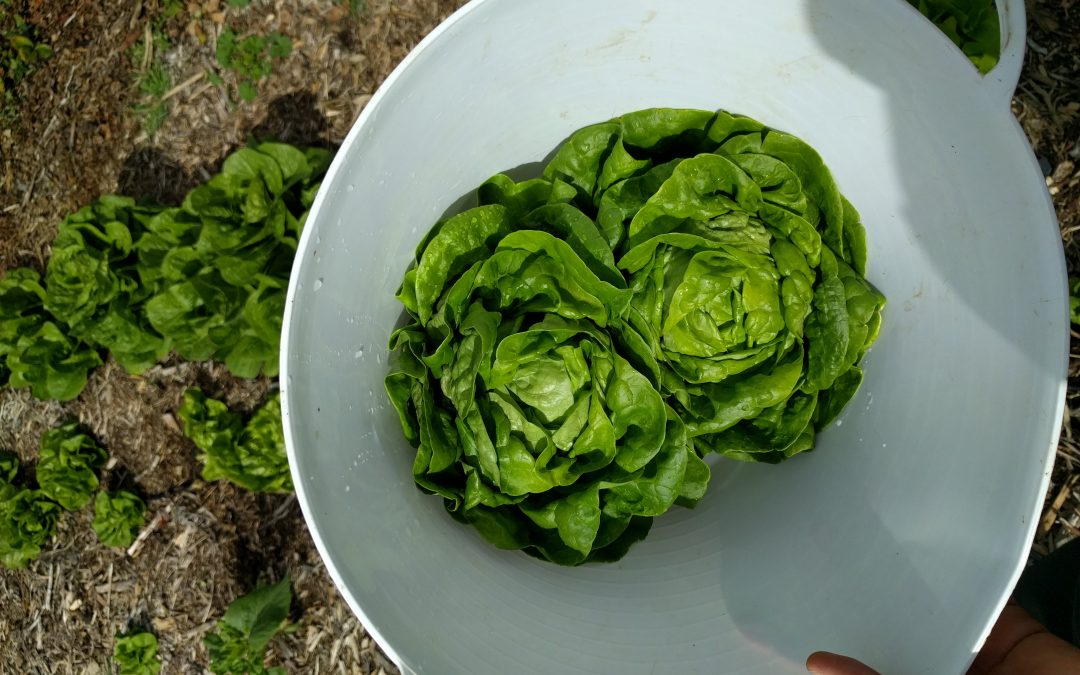
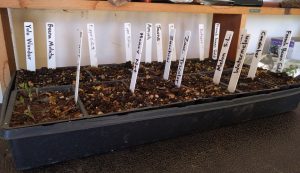

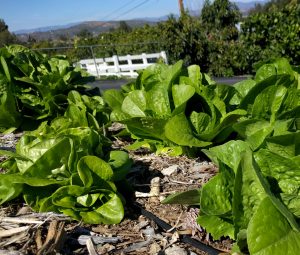

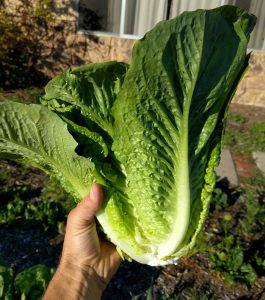

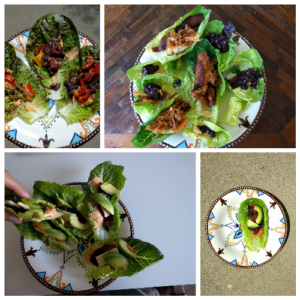


AWESOME post!
Thanks a lot Greg. I am very glad that I found your posts
Thank you for sharing. The lettuce looks beautiful. You have encouraged me to start.
Greg, what type of romaine lettuce seeds do you use? My romaine only gets a few inches tall and the leaves are very small. Thanks.
Hi Ken,
For the last few years I have been very pleased with the growth and taste of ‘Jericho’ romaine: https://www.reneesgarden.com/products/lettuce-romaine-organic-jericho
Greg, I’ve heard that Jericho is heat tolerant — I’m looking for lettuce that will grow through the summer. Did you find Jericho to grow well and not bolt/turn bitter in SoCal? Any trouble with leafhoppers?
Hi Cindy,
I grew Jericho through the summer last year. It did well through June but then started to get bitter and bolt too much from July onward even though I was watering abundantly and giving it some shade. No trouble with leafhoppers.
This summer I’m trying Magenta and Muir. A Southern California farmer recommended Magenta, and I ate some that he’d grown through summer last year that tasted great. I got seeds of both varieties from Johnny’s: https://www.johnnyseeds.com/
great post ! Unrelated to lettuce I saw that you are involved in educating the public for growing avocados. Since our housing development was built in a former avocado orchard there are still many trees that are scattered around our community. Sadly, all of the trees are doing poorly. After consulting a tree expert and the UCLA botany department I was told that avocados are like the canary in the coal mine….. they hate air pollution so few do well in recent times in urban areas. Also, like oaks they do not like wet feet and yet most homes now have their lawns planted right up to the trunk of the tree. You probably are aware of these issues but just in case I thought it may be helpful.
Hi Jim,
Thanks. These are interesting ideas. I’m curious where your housing development is. Is it on the UCLA campus? I’ve often wondered if any of the trees remain of the old subtropical orchard there.
I grew up in a town that was once primarily citrus and avocado orchards before the houses arrived (Glendora). Some of the old trees remain.
While I’m aware of some of the negative effects on avocados from air pollution, I have to note that the air in the L.A. area is a lot cleaner these days than it was when I was a kid. It seemed that then we often had smog alerts when we weren’t allowed to have P.E. classes outside. You’d feel your lungs burn if you took a deep breath.
I have to also observe that I know of both lots of healthy avocados and healthy live oaks that are growing within or beside lawns, and have done so for decades. Come to think of it, there is an old oak and an avocado growing this way at the house in which I grew up.
I am not about to say that avocados don’t mind air pollution or growing within a lawn. But the evidence is all around us that neither situation is a death knell.
Native oaks don’t get rain in the summer so their roots are adapted
to dry conditions half the year in So-Cal.
I Have seen a few oaks killed by lawns in my life time so why take a 50-50
risk of killing these great looking trees. Paving or parking cars (compressing
the soil) under the canopy is also not a good idea.
Also amazing how many people rake up the avocado leaves.
Sowing lettuce in your garage. Interesting idea! Are you using grow lights? Natural daylight?
Separately, may I ask where you buy your lettuce seeds? I’m thinking of trying lettuce in containers come the fall.
Thanks
Hi David,
I don’t use any artificial light for the seedlings in my garage, but there’s a bit of indirect light from a window. It’s not totally dark in there. And as soon as the seedlings are up and growing I move them out of the garage and into the sun or else they get weak and lanky quickly.
I buy most of my lettuce seeds from Renee’s or Johnny’s.
Hi,
Loved your post. How large do the seedlings need to be before I plant them in my raised beds? They are growing in plastic containers on a cart outside right now and I would hate for the cutworms to get them. I live in zone 14 (Palos Verdes). Thank you in advance.
Hi Anna,
Thank you. There’s no rule for that. You can technically transplant them at any stage. I just transplanted some very small iceberg lettuce seedlings and they’re doing fine, but I did that because I was confident the plants would be safe out there. I’ve got no pests bothering lettuce right now, except for rabbits which I’ve fenced out of the bed.
Bigger plants can withstand more insect munching. Therefore, if you have reason to believe that critters will attack your seedlings, then you’ll want to wait until the seedlings are bigger (and/or try to reduce the pest insect population).
Hi,
Each time I harvest a head of romaine lettuce in my garden it is infested with pincher bugs. I’ve soaked the head in water and they flee, but I would like to keep them out in the first place. Any ideas?
Hi Michelle,
I get a lot of those sometimes too. The only way I nearly eliminate them is by running my chickens through my vegetable area, as the chickens like to eat earwigs. Otherwise, I try to reduce their hiding places, such as rocks and big chunks of mulch. If you find one, scratch around because they live in large groups. I use a glove and scoop them all up and put them in a bucket when I find one of their hiding spots. Then I take them to my chickens, but you could just compost or trash them. You ought to do this while the romaine plant is still small though because once it is big they will start using the interior of the head as their hiding place (from the sun during the day). You can also go out after sunset with a flash light and find them running around and squish them. Some people use tuna cans filled halfway with cooking oil. The earwigs are attracted to it and drown in it. I’ve never found that method to kill enough to be very effective though.
They tend to almost disappear around June, in case you didn’t know. They hide out from the oncoming summer heat and they’re no longer a problem until it cools down again in the winter.
well, thanks for including a link to this older post on planting lettuce in your weekly email! I just planted some lettuce seeds in the ground; but now I think I will take the remaining seeds and plant them in flats, as you recommend to help with keeping the seedlings evenly moist as they germinate and then grow.
Salad days (or maybe lettuce “taco” days) are coming! Gene
Thank you so much for this!! I just started a small space garden on my apartment patio and I am wanting to do lettuce next since the Summer is nearly over. This will be my first attempt at lettuce and I am very excited. I only got small harvests of the squash I planted, but my tomatoes did amazing and I am hoping the lettuce will too. Does you have any recommendations on lettuce varieties to grow in San Diego in a container as I only have about a 20ft by 6ft area to grow in and I currently have black eyed peas and green beans and peppers. Everything is starting to slow down in producing except the peppers so I want to get started on things for winter. Any other suggestions?
Hi Katherine,
My favorite varieties of summer lettuce are Magenta and Muir. Try those now. (I grow all of my summer lettuce in one-gallon containers.) Come October, you can try any variety you like to eat and expect success.
Thanks for all the helpful information. I’m growing lettuce for the first time, and I had no idea it would last so long in the fridge. What is the best way to store it once it has been harvested?
Hi Dana,
After harvest, I cut off any damaged leaves on the outside and then spray the bottom of the stalk with water or dip it in a bucket to rinse the white sap off. Then I put the head in a plastic bag (not closed at the top) and place it in the fridge.
If the lettuce is wet, let it dry off somewhat before putting it into the fridge. I leave mine on a towel on the kitchen counter to dry if necessary.
Hello Greg,
Would it work to plant lettuce in a container now? I don’t have a place to grow seedlings indoors and I don’t want to plant directly in the ground because of so many animals in the yard – squirrels, opossums, raccoons, skunks. Do you have any advice about planting in pots outdoors? Thank you..
Hi Claudia,
For sure! I have some of my lettuce growing in containers right now even though most are in the ground. My main advice is to buy high quality, high fertility potting mix. See my post on summer lettuce for a couple recommendations: https://gregalder.com/yardposts/growing-summer-lettuce-in-southern-california/